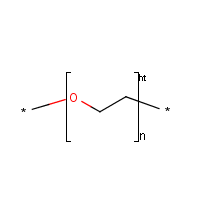Polyethylene glycol
Agent Name
Polyethylene glycol
CAS Number
25322-68-3
Formula
(C2-H4-O)mult-H2-O
Major Category
Other Classes

Synonyms
1,2-Ethanediol homopolymer; Alcox E 30; Alkox E 100; Alkox E 130; Alkox E 160; Alkox E 240; Alkox E 45; Alkox E 60; Alkox E 75; Alkox R 1000; Alkox R 15; Alkox R 150; Alkox R 400; Alkox SR; Antarox E 4000; Aquacide III; Aquaffin; Atpeg 300; BDH 301; Badimol; Bradsyn PEG; Breox 2000; Breox 20M; Breox 4000; Breox 550; Breox PEG 300; CAFO 154; Carbowax; Carbowax 100; Carbowax 1000; Carbowax 1350; Carbowax 14000; Carbowax 1500; Carbowax 20; Carbowax 200; Carbowax 20000; Carbowax 25000; Carbowax 300; Carbowax 3350; Carbowax 400; Carbowax 4000; Carbowax 4500; Carbowax 4600; Carbowax 600; Carbowax Sentry; DD 3002; Deactivator H; Emkapol 4200; Ethoxylated 1,2-ethanediol; Ethylene glycol homopolymer; Ethylene glycol polymer; Gafanol E 200; Glycols, polyethylene; HM 500; Lutrol; Macrogol; Merpol OJ; Miralax; Modopeg; Nosilen; Nycoline; Oxide Wax AN; Oxyethylene polymer; PEG; PEG 3350; PEG 400; PEG 4000; PEG 6000DS; Pluracol E; Pluracol E 400, E 600, E 1450; Pluriol E 200; Poly(oxy-1,2-ethanediyl, alpha-hydro-omega-hydroxy-; Poly-G; Poly-G600; Polyoxyethylene ether; alpha-Hydro-omega-hydroxypoly(oxy-1,2-ethanediyl); alpha-Hydro-omega-hydroxypoly(oxyethylene); [ChemIDplus]
Category
Polyoxyethylenes
Description
Colorless viscous liquid; Slightly hygroscopic; [ICSC] Clear viscous solids or liquids; [AIHA]
Sources/Uses
Used as water-soluble lubricants for rubber molds, textiles, metalworking, and ceramics production; Also used in food packaging, water-based paints, polishes, paper coatings, ointments, suppositories, dispersing agents, and chemical intermediates; [AIHA] "Polyethylene glycol (PEG) is a polyether compound with many applications from industrial manufacturing to medicine. . . . PEG is also known as polyethylene oxide (PEO) or polyoxyethylene (POE), depending on its molecular weight." [Wikipedia]
Comments
Specific polyethylene glycol compounds (PEGs) are identified by a numeral in the name referring to the average molecular weight that range from 200 to >6000. Chemical properties and adverse effects depend on the molecular weight of the specific compound. Compounds with average molecular weights >1000 are solids at room temperature. Lower molecular weight PEGs cause contact urticaria. [AIHA] No listed effects of short-term or long-term exposure; [ICSC]
Biomedical References
Exposure Assessment
MAK
200 mg/m3, inhalable fraction (av. molecular weight 200-600)
Explanatory Notes
VP = <0.01 mmHg at 20 deg C; [AIHA]
NFPA
must be preheated
WEEL
10 mg/m3, for molecular weight >200
Diseases, Processes, and Activities Linked to This Agent
Diseases
Occupational diseases associated with exposure to this agent:
Processes
Industrial Processes with risk of exposure: